
Finding the right target audience for your survey can make a valuable difference between collecting relevant data and pilling heaps of unrelatable answers.
If you cannot spot your right audience you will end up collecting irrelevant, vague, and inaccurate data for your research.
This is where screening survey questions come to your rescue!
Screening survey questions shortlist the right audience from your group of survey takers. These initial questions try to analyze their choices and behavioral pattern to sort the right fit for your survey research. If they fit the business’s specific needs, they are shown additional questions and their feedback is collected. If not, they are exempted from taking your survey.
With a screening survey question, you can reduce costs as well as save survey time for both your audience as well as your organization.
This blog gives you a complete understanding of framing screening survey questions and using them to set your business for success. Let’s get started.
What Are Screening Questions?
Imagine you want to conduct a survey on ‘what people look for in a writing course?’. Your ideal target audience will be writers and authors. In this case, you can use screening survey questions to know if your audience is interested in writing.
Some screener questions that you can include in your survey are:
Q 1. How do you describe yourself
a. Creative writer
b. Content writer
c. Author
d. I am a passive writer
e. I do not write
Here, if the survey takers select the option (a), (b), (c), they are your ideal audience. They can be guided to a separate page to know their writing interest further.
If the answer selection is (d) and (e), they can be guided to the end of the survey. Asking questions on a writing course will be redundant for both the survey takers as well as the organization.
Read more: 250+ Survey Questions Examples
In the next section, let us understand the type of screening questions.
Types of Screening Survey Questions
Screening survey questions vary based on the industry in which you are conducting a survey or based on the behavioral choices of your target audience.
1. Industry-Specific Questions
In this type of screener survey question, you try to eliminate those respondents who are either positively or negatively biased towards your brand. This happens because they either work in the same industry or know someone who works in the same industry.
For example, let us consider a question,
1. “In which industry do you work or know someone working in a particular industry?”
a. Automobile
b. Marketing
c. Banking
d. Fashion
Here, if you are conducting market research on the fashion industry, you may want to exclude people working in that industry or have acquaintances from the fashion industry. This leads to an impartial and genuine feedback collection. Hence, if the respondent selects option (d), you can guide them to the end of the survey page.
2. Behavioral Type Questions
Behavioral type audience survey questions try to gauge the behavior of your survey respondents: How often do they purchase a product or service? What are their food habits? What are their hobbies? And more.
Let’s consider few screening questions examples,
1. “How often do you travel to see places?”
a. Every week
b. Once a month
c. Once in 2-3 months
d. I do not travel
Here, if your survey respondents select option (d), you can directly take them to the end of the survey and avoid asking them travel-related questions.
2. “How frequently do you eat non-vegetarian food?”
a. More than once a week
b. Once a week
c. Once in 2 weeks
d. Once a month
e. Everyday
f. I never eat non-veg
In this case, you can pose the subsequent questions related to non-vegetarian food only to people who select options (a) to (e).
Now that you have understood the screening questionnaire, let’s look at the benefits of using screening survey questions.
Benefits of Using Screening Survey Questions
Online screening questions come with a number of benefits ranging from cost-effectiveness to focussed targeting of your audience. Let’s understand this in detail.
1. Focused Targeting of Audience
When you ask the screening questions right at the beginning of the survey, you get to know whether the survey topic resonates with your audience. In such a situation, you can collect feedback from the right audience by narrowing down your survey takers.
2. Cost-Effective
The logistics cost associated with creating and analyzing survey questions is huge when you go for a market panel approach. The more the responses, the more challenging is the response analysis leading to increased costs.
3. Reduces Survey Response Bias
With screening questions, you can eliminate those people from taking the survey who do not have much knowledge about the survey topic or who might be biased towards or against your brand. In this way, you can improve your data quality by collecting honest and reliable information.
4. Effective Analysis of Survey Responses
With fewer responses, it is easy to analyze the survey data. You will not end up wasting time by filtering out the unanswered questions or partially answered questions.
Read more: How Surveys Improve Your Customer Experience
After understanding the benefits of framing screening survey questions, let us learn more about the best practices while designing a survey.
Best Practices While Framing Screening Survey Questions
1. Ask Screening Survey Questions at the Beginning of Your Survey
Screening survey questions are usually asked at the beginning of a survey. When you place the questions in the initial stages of your survey, you can filter out the non-desirable respondents before collecting more solid and valuable information from your target audience. By doing so, you do not waste the precious time of your survey respondents as well as save logistical costs involved in conducting large surveys.
2. Use Multiple Screening Questions
Sometimes, one question is not sufficient enough to screen out your survey takers. You may have to ask a couple of more questions to understand their real behavior and choices. Feel free to ask more questions to your respondents so that you don’t miss out on the right respondents or include the wrong survey respondents.
3. Avoid Yes/No Type Questions
Yes/No type of questions lead to a phenomenon called acquiescence bias. In this type of survey bias, the respondents have a tendency to give only positive responses to survey questions. This is to feel more likable and socially desirable.
Read More: How to Eliminate Survey Bias
4. Limit the Use of Excessive Answer Options
Excessive answer options can be very overwhelming for the survey respondents to select and choose from. Further, it is easy for respondents to get confused and give a non-reliable and vague answer.
Let’s take an example:
1. “How many times in a week do you play video games?”
a. Once
b. Twice
c. Thrice
d. Four times
e. Five times
f. Six times
g. Seven times
Instead of so many options, you can limit it to a maximum of four options. It ensures that your survey respondents do not have to spend more time thinking about an answer.
a. Once
b. Twice
c. Thrice
d. More than 3 times
Read more: Different Types of Survey Question Types
5. Avoid Leading and Loaded Type of Questions
While leading questions lead your survey respondents to give a biased and predetermined answer, loaded questions confuse your respondents to give an inaccurate answer.
Let’s consider some examples.
A. Leading question
“How do you rate our awesome customer support?”
Here, a bias is being created in the minds of survey respondents that the customer support is awesome, forcing them to give a positive response to the question.
B. Loaded question
“How do you rate our breakfast and lunch service?”
Here, you are asking for a response to two different services (breakfast and lunch) in a single question. The respondents may have liked one service but not the other. They will be confused as to what response to give resulting in either a dishonest answer or an unanswered question.
Read more: Tips to Avoid Leading and Loaded Questions
6. Make Use of Branching and Skip Logic
Branching and skip logic-type questions are essential to qualify or disqualify your survey respondents. For example, if the survey respondent passes the screening test, you can take them to a page with further questions on the survey topic. If not, you can guide them to an exit page or the thank you page. Alternatively, you can also collect their contact details for future reference.
Survey tools like ProProfs Survey Maker come with a powerful branching and skip logic feature using which you can design screening survey questions in minutes.
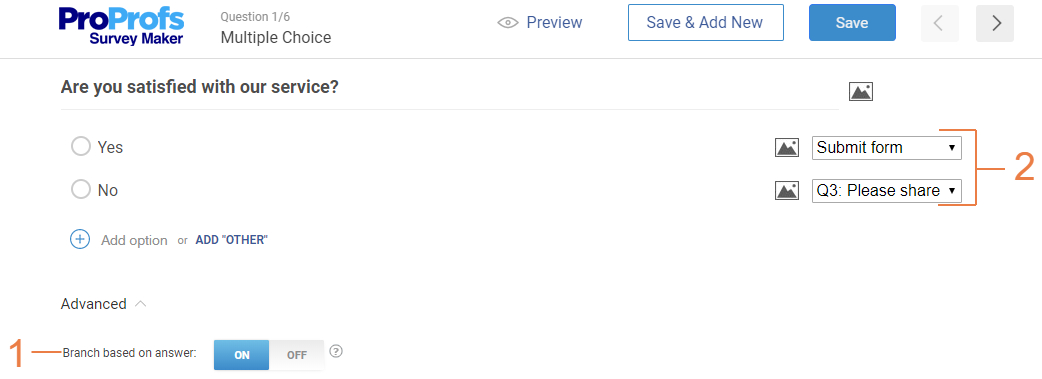
7. Include Page Breaks After the Screening Questions
Page breaks in a survey are necessary to prevent survey fatigue. Your survey respondents can get overwhelmed when they see many survey questions on a single page. The same is the case with screening questions. Even if they are not the right fit for the survey, they feel that the questions need to be answered. But, when you enter a page break, they just need to concentrate on the 1-2 screener questions.
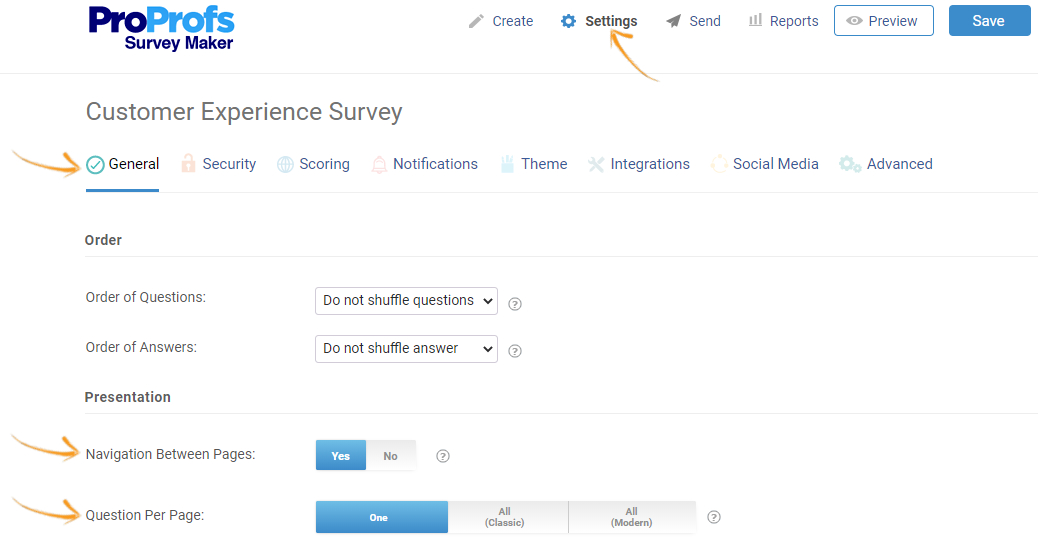
Explore more: How to Enable Navigation in Surveys
8. Proper Translation of Multilingual Surveys
Multilingual surveys are a great way to reach out to diverse groups of people globally. But, multilingual surveys could face the challenge of translation errors leading to the misinterpretation of questions. Ensure using an accurate and powerful translation tool for your screening question.
Survey software like ProProfs Survey Maker supports survey creation in 90+ languages. Let’s see how it works:
Step 1: Go to the Settings option on ProProfs Survey Maker Dashboard

Step 2: Locate the language setting and select your preferred language
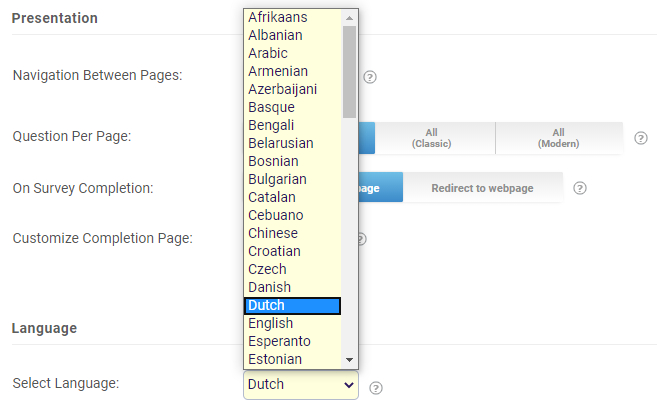
Read more: 20 Best Online Survey Software
8. Use a Simple and Jargon Free Language
Avoid complex language cum vocabulary in your screener survey. They tend to confuse the survey takers and may lead to misinterpretation of your survey questions. Your survey takers either drop out of the survey or choose to give wrong answers.
In the next section, let’s see how we can decide the sample size of our survey to accommodate screening questions.
FREE. All Features. FOREVER!
Try our Forever FREE account with all premium features!
How to Decide the Sample Size of Your Survey?
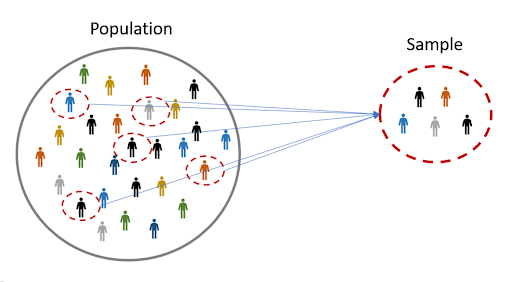
To decide the sample size of your survey, you can make use of a technique called incidence rate calculation.
The incidence rate gives you the number of people who successfully pass the screening test and go on to complete your survey. It can be calculated using the following formula:
Incidence rate = { No: of people who pass the screening test/ Total number of people who took the survey} *100.
Let’s understand with the help of an example,
Imagine that you surveyed 200 people but only 100 passed the screening test. That means your incidence rate stands at 50%.
Incidence rate = (100/200) * 100 = 50%
That means if you are expecting an incidence rate of 50% and want to collect 100 total survey responses, you need to ideally send your survey to 200 people. Based on your industry, survey costs, survey purpose, and incidence rate, you can determine your ideal survey sample size to gain optimum results.
Now that you have looked at how to create and send a screener survey, let’s learn to effectively analyze screening survey responses.
How to Analyze Your Screening Survey Responses
Screening survey response is easier to analyze as compared to a normal survey response. All you need to do is just filter out the total survey responses from the total survey completion responses. Total survey responses include all your survey respondents who took up your screening questions. Those who fail this test are excluded from the rest of the survey process. Hence, total survey completion responses include responses by people who pass the screening test.
A powerful survey maker tool like ProProfs Survey Maker comes with an advanced filtering option to see the survey responses: Who took the survey? The number of people who passed the screening test, and more.
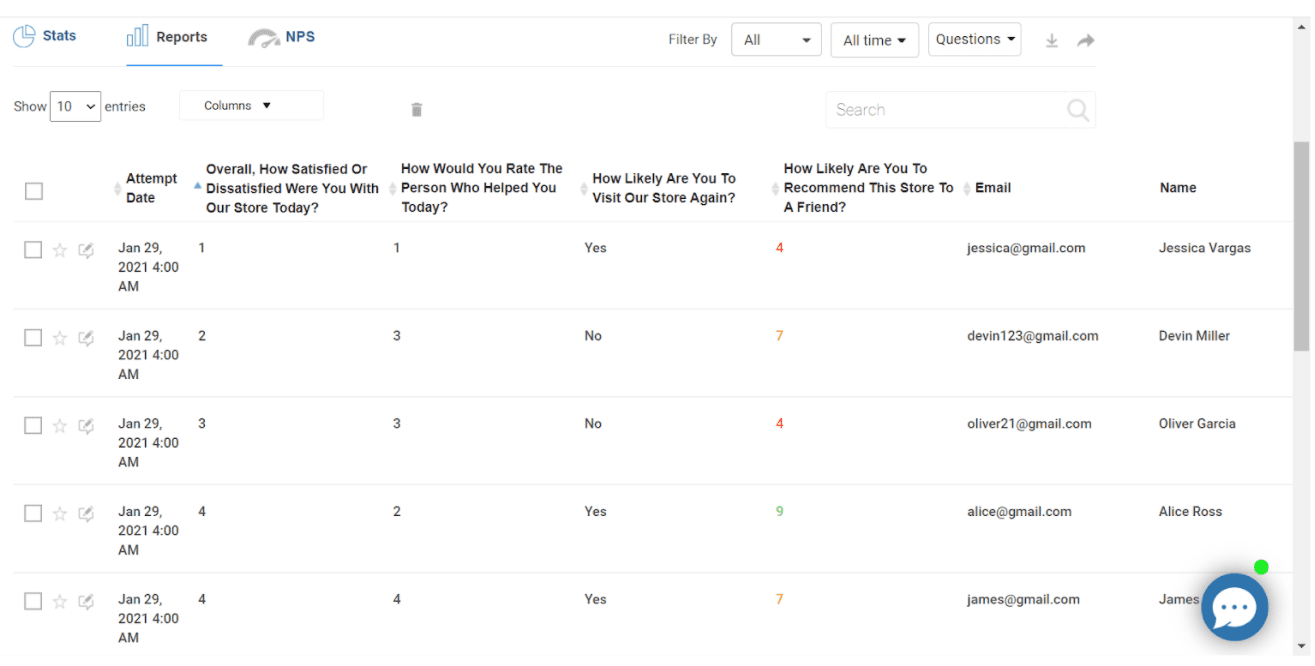
Read more: How to Analyze Survey Data Like a Pro
Power Up Your Survey Quality with Screening Questions
Screening survey questions help you collect relevant and actionable feedback data from your target audience. Introducing it at the beginning of the survey ensures that only the right survey takers are shown the rest of the survey questions. This will help you create a positive survey experience for the audience who are willing to give you valuable inputs.
Certain best practices help you to frame screening questions to receive encouraging responses. Avoid leading or loaded questions that create bias and confusion in the minds of the audience. Also, make sure that the survey experience is smooth by including page breaks and branching types of questions.
Looking to create your first screener survey? ProProfs Survey Maker gives you the right features like Branching Logic, Page Breaks, Multilingual Survey Option, and more to create your surveys in minutes.
FREE. All Features. FOREVER!
Try our Forever FREE account with all premium features!

 We'd love your feedback!
We'd love your feedback!
 Thanks for your feedback!
Thanks for your feedback!







